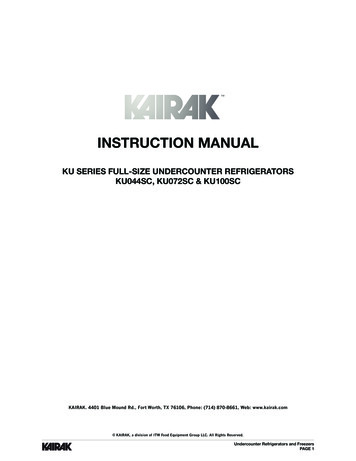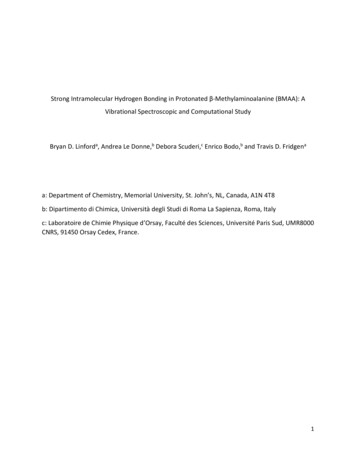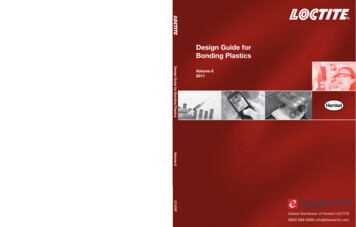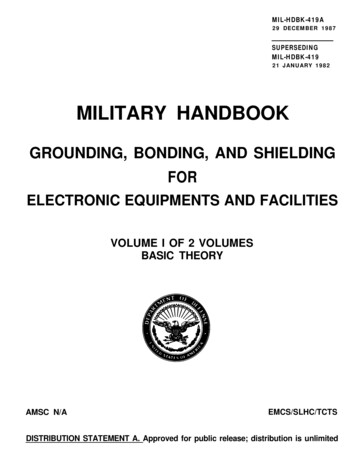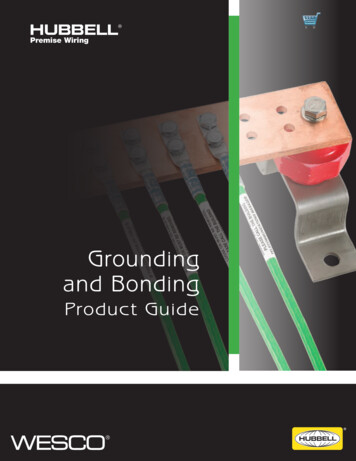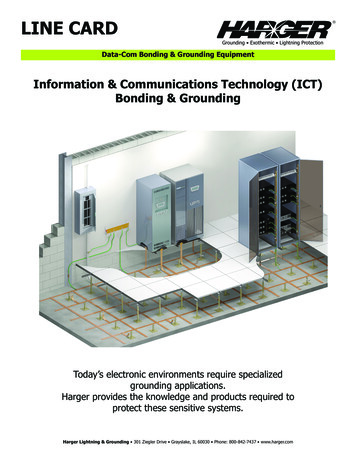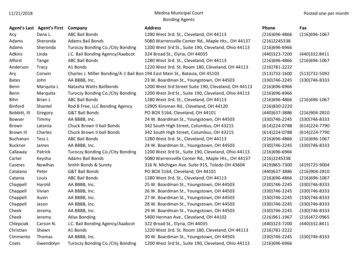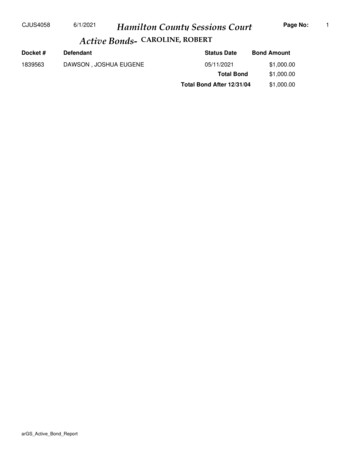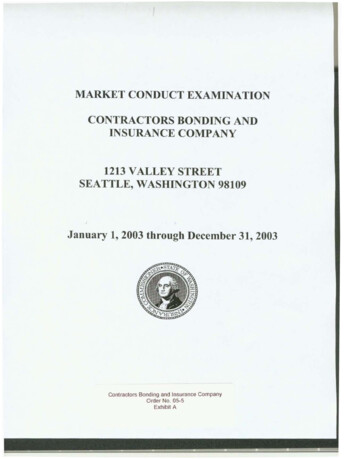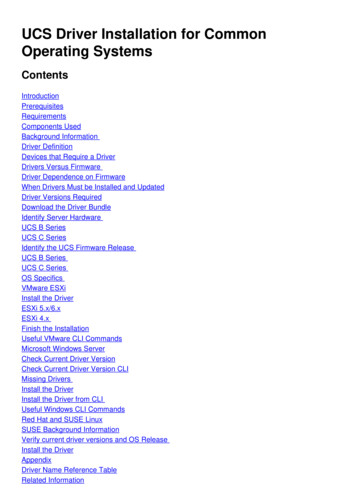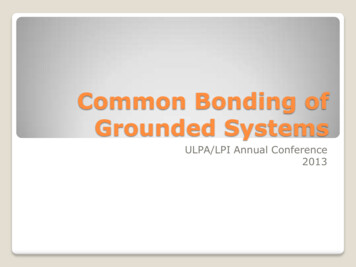
Transcription
Common Bonding ofGrounded SystemsULPA/LPI Annual Conference2013
NEC - 250.52 Grounding Electrodes.(A) Electrodes Permitted for Grounding.1. Metal Underground Water Pipe. A metalunderground water pipe in direct contact with theearth for 3.0 m (10 ft.) or more .2. Metal Frame of the Building or Structure. Themetal frame of the building or structure that isconnected to the earth .3. Concrete-Encased Electrode. A concrete-encasedelectrode shall consist of at least 6.0 m (20 ft.) ofeither .4. Ground Ring. A ground ring encircling the buildingor structure, in direct contact with the earth,consisting of5. Rod and Pipe Electrodes. Rod and pipe electrodesshall not be less than 2.44 m (8 ft.) in length andshall consist of the following materials .6. Other Listed Electrodes.7. Plate Electrodes. Each plate electrode shall exposenot less than 0.186 m2 (2 ft2) of surface to exteriorsoil.8. Other Local Metal Underground Systems orStructures.
NEC - 250.52 Grounding Electrodes –(contd.)(B) Not Permitted for Use as GroundingElectrodes. The following systems andmaterials shall not be used as groundingelectrodes:(1) Metal underground gas piping systems(2) Aluminum
NEC - 250.50 Grounding ElectrodeSystem.All grounding electrodes as described in250.52(A)(1) through (A)(7) that arepresent at each building or structure servedshall be bonded together to form thegrounding electrode system. Where none ofthese grounding electrodes exist, one ormore of the grounding electrodes specifiedin 250.52(A)(4) through (A)(8) shall beinstalled and used.
250.68 Grounding Electrode Conductor and BondingJumper Connection to Grounding Electrodes.The connection of a grounding electrode conductor at theservice, at each building or structure where supplied by afeeder(s) or branch circuit(s), or at a separately derivedsystem and associated bonding jumper(s) shall be made .(A) Accessibility. All mechanical elements used to terminatea grounding electrode conductor or bonding jumper to agrounding electrode shall be accessible.(B) Effective Grounding Path. The connection of agrounding electrode conductor or bonding jumper to agrounding electrode shall be made in a manner that willensure an effective grounding path.(C) Metallic Water Pipe and Structural Metal. Groundingelectrode conductors and bonding jumpers shall be permittedto be connected at the following locations and used to extendthe connection to an electrode(s):(1) Interior metal water piping located not more than 1.52 m(5 ft.) from the point of entrance to the building shall bepermitted to be used as a conductor to interconnectelectrodes that are part of the grounding electrode system.(2) The structural frame of a building that is directlyconnected to a grounding electrode
NEC - 250.104 Bonding of Piping Systems andExposed Structural Steel. (A) Metal Water Piping Metal water pipingsystem(s) installed in or attached to a building orstructure shall be bonded to the service equipmentenclosure, the grounded conductor at the service, thegrounding electrode conductor where of sufficientsize, or to the one or more grounding electrodesused. (B) Other Metal Piping. If installed in, or attachedto, a building or structure, a metal piping system(s),including gas piping, that is likely to becomeenergized shall be bonded (C) Structural Metal. Exposed structural metal thatis interconnected to form a metal building frame andis not intentionally grounded or bonded and is likely tobecome energized shall be bonded (D) Separately Derived Systems. Metal waterpiping systems and structural metal that isinterconnected to form a building frame shall bebonded to separately derived systems
ANSI/TIA-607-B GenericTelecommunications Bonding andGrounding (Earthing) for CustomerPremisesThis Standard provides basic principles,components, and design oftelecommunications bonding and groundingthat shall be followed to ensure that thetelecommunication bonding and groundingsystems within a building will have oneelectrical potential.
For a designer of telecommunications bonding andgrounding systems, the ANSI/TIA-607-B standard is themost encompassing standard to follow for premisesbuildings.For electrical contractors subcontracting out thetelecommunications work, the demarcation point for workbetween electrical and telecommunications contractorsshould be carefully coordinated. A recommended practiceis for the electrical contractor to provide the groundingconductor and connection from the main electrical groundto the TMGB, as well as from an electrical panel in atelecommunications room to the grounding busbar in thatroom. The telecommunications contractor would thenprovide all of the grounding busbars and bondingconductors within and between the telecommunicationsrooms, as well as make all final connections to the TMGB,TGBs, and telecommunications infrastructure / equipment.(TMGB Telecommunication Main Ground Bar)
--------------2014Edition
NFPA 780 - 20144.14 Common Bonding of Grounded Systems.4.14.1 General. All grounded media and buried metallicconductors that can assist in providing a path for lightningcurrents in or on a structure shall be interconnected to thelightning protection system within 3.6 vertical meters (12vertical feet) of the base of the structure to provide acommon ground potential.4.14.2 For structures exceeding 18 m (60 ft.) in height, theinterconnection of the lightning protection system groundingelectrodes and other grounded media shall be in the form of aground loop conductor.4.14.3 This interconnection shall include all buildinggrounding electrode systems including lightning protection,electric service, communication, and antenna systemgrounding electrodes.4.14.4 Interconnection of underground metallic pipingsystems shall include water service, well casings locatedwithin 7.6 m (25 ft.) of the structure, gas piping,underground conduits, underground liquefied petroleum gaspiping systems, and so on. If the water pipe is notelectrically continuous due to the use of plastic pipe sectionsor other reasons, the nonconductive sections shall be bridgedwith main size conductors, or the connection shall be made ata point where electrical continuity is ensured.
When the building groundedsystems noted above areinterconnected at a commonaccessible point in or on thestructure, the lightning protectionsystem shall have only one main sizeconductor connected to the commonbonding point. This commonbonding point shall include a groundbar, a section of water pipe, or themetallic structural frame per NFPA70.4.14.5
4.14.6 Where bonding of the lightning protection grounding system,grounded media, and buried metallic conductors has not beenaccomplished at a common point, interconnection shall be providedaccording to the following:A.Grounded media and buried metallic conductors shall be bondedto the lightning protection grounding system below a height 12ft. (3.6 m) vertically above the base of the structure.B.Grounded media and buried metallic conductors inherentlybonded through construction to the lightning protectiongrounding system shall not require further bonding.C.The continuous metal framework of a structure shall beconnected to the lightning protection system (See 4.9.13 and4.16).D.Main size lightning conductors shall be used for directconnection of grounded media and buried metallic conductors tothe lightning protection system.E.A ground bar designed for interconnection of building groundedsystems shall have one connection to the lightning protectionsystem.F.A continuous metal water pipe system designed forinterconnection of building grounded systems shall beconnected to the lightning protection system.G.Interconnection to a gas line shall be made on the customer’sside of the meter.H.Where galvanic corrosion is a concern or where a direct bond isprohibited by local code, an isolating spark gap shall bepermitted.
w here:d horizontal distance from l.p. system component to grounded body in questionh vertical height betw een bond under consideration and actual bond to the l.p. systemvalue related to dow n conductors 25 ft. (7.6 m) apart w ithin 100 ft. (30 m) zone of bondn under considerationn 1 w here only 1 dow nconductor in the zonen 1.5 w here only 2 dow nconductors in the zonen 2.25 w here 3 or more dow nconductors in the zonen total number of system dow nleads below 60 ft. (18 m) from top ground loop (roof circuit)Km medium betw een l.p. system and grounded body in questionKm 1 if flashover w ill occur through airKm 0.50 if flashover w ill occur through non-metallic building materialsVariable Valueh 60(insert height to nearest bond w ith l.p. system)n 1.5(insert value for n from above - 1, 1.5, 2.25, or total of dow nleads)Km d 16.7(insert value for Km from above - 1 or 0.50)(calculated distance w ithin w hich a bond betw een systems is required or potentialsideflash distance)
UL STP Proposals10. New UL 96A Proposal - Addition of Paragraph 10.4.4RATIONALEParagraph 10.4.4 proposed to be added to accommodate compliance to changes in NFPA 70PROPOSAL10.4.4 If utility services are grounded to a common bus bar, then common (equipotential) bonding shallbe accomplished by attaching a main size conductor to that bus bar with an appropriately sized bondingfitting.14. New UL 96A Proposal - Revisions to Section 11RATIONALEThese proposed revisions provide a simple and easily inspectable rule to install to that closelyapproximates the bonding distances required by the formula currently in this standard and NFPA 780.PROPOSAL11.4 Grounded metal bodies that are on a roof that is 60 feet or less above grade shall be bonded to mainconductor if they are within six feet or less to that conductor. within 6 feet (1.8 m) of the main conductorshall be bonded to the system.11.5 The bonding distance for grounded metal bodies on a roof over 60 feet shall be one foot for everyten feet of elevation above grade or portion there, of up to a maximum distance of twenty feet. Groundedmetal bodies that are more than 6 feet (1.8 m) from the main conductor where an isolated metal body willinfluence the distance shall comply with 11.6.11.6 Where the sum of the distances between an isolated metal body and a grounded metal body andthe distance between this isolated metal body and the main conductor is less than 6 feet (1.8 m) asillustrated in Figure 11.4, bonding from the grounded metal body to the main conductor is required.11.7 Isolated metal bodies that show no conductance to ground shall not require bonding.Exception: For down conductors, only grounded metal bodies that are within the first 6 feet (1.8 m) ofthe main conductor shall be bonded to the system. Isolated metal bodies that comply with 11.7 need nofurther bonding.11.8 A grounded metal body shall be bonded at the closest point to the system using bonding conductorsand fittings. See 9.4.2 and Table SA1.2 for secondary conductors. See 12.11.
UL STP Proposals15. New UL 96A Proposal - Grounded Metal BodiesRATIONALEThe intent of the proposal is to include requirements that specify when to bond multiple roof topgrounded metal bodies and avoid daisy chaining.PROPOSAL11.4 Grounded metal bodies that are within 6 feet (1.8 m) of the main conductor shall be bonded to thesystem.11.4.1 Where the sum of the distances between a main conductor and a bonded (grounded) metal bodyand the distance from the bonded (grounded) metal body to other grounded metal bodies is 6 feet (1.8m)or more, no additional bonding of the grounded metal bodies is needed.
NFPA 70 National Electrical Code2011 Edition250.106 Lightning Protection Systems. The lightningprotection system ground terminals shall be bonded tothe building or structure grounding electrode system.Informational Note No. 1: See 250.60 for use of striketermination devices. For further information, see NFPA780-2011, Standard for the Installation of LightningProtection Systems, which contains detailed informationongrounding, bonding, and sideflash distance from lightningprotection systems.Informational Note No. 2: Metal raceways, enclosures,frames, and other non–current-carrying metal parts ofelectrical equipment installed on a building equipped witha lightning protection system may require bonding orspacingfrom the lightning protection conductors in accordancewith NFPA 780-2011, Standard for the Installation ofLightning Protection Systems.NFPA 1310.6.8* In no case shall the underground piping beused as agrounding electrode for electrical systems.10.6.8.1* The requirement of 10.6.8 shall notpreclude thebonding of the underground piping to the lightningprotectiongrounding system as required by NFPA 780 in those caseswhere lightning protection is provided for the structure.NFPA 54ANSI Z223.1National Fuel Gas Code2012 Edition7.13.3* Prohibited Use. Gas piping shall not be usedas agrounding conductor or electrode.7.13.4* Lightning Protection Systems. Where alightning protectionsystem is installed, the bonding of the gas piping shallbe in accordance with NFPA 780, Standard for theInstallation ofLightning Protection Systems.NFPA 24Standard for the Installation of PrivateFire Service Mains and Their10.6.8* In no case shall the underground piping beused as agrounding electrode for electrical systems.10.6.8.1* The requirement of 10.6.8 shall notStandard for the Installation ofSprinkler Systems2010 EditionOther NFPA Standards
NFPA 780 - 2014 4.14 Common Bonding of Grounded Systems. 4.14.1 General. All grounded media and buried metallic conductors that can assist in providing a path for lightning currents in or on a structure shall be interconnected to the lightning protection system within 3.6 vertical meters (12 vertical feet) of the base of the structure to provide a
